Contribution Ratio Assessment of Process Parameters on Robotic Milling Performance
Abstract
1. Introduction
2. Experiment
2.1. Experimental Setup
2.2. Evaluation Method
3. Results and Discussion
3.1. Milling Load
3.2. Surface Quality
3.3. Vibration
4. Conclusions
Author Contributions
Funding
Institutional Review Board Statement
Informed Consent Statement
Data Availability Statement
Conflicts of Interest
References
- Mikołajczyk, T. System to Surface Control in Robot Machining. Adv. Mater. Res. 2012, 463–464, 708–711. [Google Scholar] [CrossRef]
- Chen, Y.H.; Hu, Y.N. Implementation of a Robot System for Sculptured Surface Cutting. Part 1. Rough Machining. Int. J. Adv. Manuf. Technol. 1999, 15, 624–629. [Google Scholar] [CrossRef]
- Mikolajczyk, T. Manufacturing Using Robot. Adv. Mater. Res. 2012, 463–464, 1643–1646. [Google Scholar] [CrossRef]
- Riviere-Lorphevre, E.; Huynh, H.N.; Ducobu, F. Cutting Force Prediction in Robotic Machining. In Proceedings of the 17th CIRP Conference on Modelling of Machining Operations (CIRP CMMO), AMRC, Sheffield, UK, 13–14 June 2019; pp. 509–514. [Google Scholar] [CrossRef]
- Ji, W.; Wang, L.H. Industrial robotic machining: A review. Int. J. Adv. Manuf. Technol. 2019, 103, 1239–1255. [Google Scholar] [CrossRef]
- Klimchik, A.; Ambiehl, A.; Garnier, S. Experimental study of robotic-based machining. In Proceedings of the 8th IFAC Conference on Manufacturing Modelling, Management and Control (MIM), Troyes, France, 28–30 June 2016; pp. 174–179. [Google Scholar] [CrossRef]
- Singh, G.; Pruncu, C.I.; Gupta, M.K. Investigations of Machining Characteristics in the Upgraded MQL-Assisted Turning of Pure Titanium Alloys Using Evolutionary Algorithms. Materials 2019, 12, 999. [Google Scholar] [CrossRef] [PubMed]
- Cordes, M.; Hintze, W.; Altintas, Y. Chatter stability in robotic milling. Robot. Compute. Integra. Manuf. 2019, 55, 11–18. [Google Scholar] [CrossRef]
- Celikag, H.; Ozturk, E.; Sims, N.D. Can mode coupling chatter happen in milling? Int. J. Mach. Tool. Manufact. 2021, 165, 103738. [Google Scholar] [CrossRef]
- Cen, L.J.; Melkote, S.N.; Castle, J. A Method for Mode Coupling Chatter Detection and Suppression in Robotic Milling. ASME J. Manuf. Sci. Eng. 2018, 140, 081015. [Google Scholar] [CrossRef]
- Tao, J.F.; Qin, C.J.; Xiao, D.Y. Timely chatter identification for robotic drilling using a local maximum synchrosqueezing-based method. J. Intell. Manuf. 2019, 31, 1243–1255. [Google Scholar] [CrossRef]
- Li, M.J.; Huang, D.X.; Yang, X.J. Chatter stability prediction and detection during high-speed robotic milling process based on acoustic emission technique. Int. J. Adv. Manuf. Technol. 2021, 117, 1589–1599. [Google Scholar] [CrossRef]
- Kim, S.H.; Nam, E.; Ha, T.I. Robotic Machining: A Review of Recent Progress. Int. J. Precis. Eng. Manuf. 2019, 20, 1629–1642. [Google Scholar] [CrossRef]
- Kihlman, H.; Eriksson, I.; Ennis, M. Robotic Orbital Drilling of Structures for Aerospace Applications. In Proceedings of the 2002 SAE Aerospace Automated Fastening Conference & Exhibition, Chester, UK, 1–3 October 2002; p. 380. [Google Scholar] [CrossRef]
- Hao, D.X.; Wang, W.; Liu, Z.H. Experimental study of stability prediction for high-speed robotic milling of aluminum. J. Vib. Control 2019, 26, 387–398. [Google Scholar] [CrossRef]
- Yin, F.C.; Ji, Q.Z.; Wang, C.Z. Research on machining error prediction and compensation technology for a stone-carving robotic manipulator. Int. J. Adv. Manuf. Technol. 2021, 115, 1683–1700. [Google Scholar] [CrossRef]
- Chen, Q.S.; Dai, L.; Liu, Y. A cortical bone milling force model based on orthogonal cutting distribution method. Adv. Manuf. 2020, 8, 204–215. [Google Scholar] [CrossRef]
- Tunc, L.T.; Shaw, J. Experimental study on investigation of dynamics of hexapod robot for mobile machining. Int. J. Adv. Manuf. Technol. 2015, 84, 817–830. [Google Scholar] [CrossRef]
- Abou-El-Hossein, K.A.; Kadirgama, K.; Hamdi, M. Prediction of cutting force in end-milling operation of modified AISI P20 tool steel. J. Mater. Process. Technol. 2006, 182, 241–247. [Google Scholar] [CrossRef]
- Neto, H.K.; Diniz, A.E.; Pederiva, R. The influence of cutting forces on surface roughness in the milling of curved hardened steel surfaces. Int. J. Adv. Manuf. Technol. 2015, 84, 1209–1218. [Google Scholar] [CrossRef]
- Lu, X.H.; Zhang, H.X.; Jia, Z.Y. Floor surface roughness model considering tool vibration in the process of micro-milling. Int. J. Adv. Manuf. Technol. 2017, 94, 4415–4425. [Google Scholar] [CrossRef]
- Ratnam, C.; Vikram, K.A.; Ben, B.S. Process monitoring and effects of process parameters on responses in turn-milling operations based on SN ratio and ANOVA. Measurement 2016, 94, 221–232. [Google Scholar] [CrossRef]
- Salur, E.; Kuntoglu, M.; Aslan, A. The Effects of MQL and Dry Environments on Tool Wear, Cutting Temperature, and Power Consumption during End Milling of AISI 1040 Steel. Metals 2021, 11, 1674. [Google Scholar] [CrossRef]
- Pan, Z.X.; Zhang, H.; Zhu, Z.Q. Chatter analysis of robotic machining process. J. Mater. Process. Technol. 2005, 173, 301–309. [Google Scholar] [CrossRef]
- Zhang, Y.R.; Guo, K.; Sun, J. Investigation on the milling performance of amputating clamping supports for machining with industrial robot. Int. J. Adv. Manuf. Technol. 2019, 102, 3573–3586. [Google Scholar] [CrossRef]
- Yuan, L.; Sun, S.S.; Pan, Z.X. Mode coupling chatter suppression for robotic machining using semi-active magnetorheological elastomers absorber. Mech. Syst. Signal Processing 2018, 117, 221–237. [Google Scholar] [CrossRef]
- Pillai, J.U.; Sanghrajka, I.; Shunmugavel, M. Optimization of multiple response characteristics on end milling of aluminium alloy using Taguchi-Grey relational approach. Measurement 2018, 124, 291–298. [Google Scholar] [CrossRef]
- Chen, C.; Peng, F.Y.; Yan, R. Stiffness performance index based posture and feed orientation optimization in robotic milling process. Robot. Comput.-Integr. Manuf. 2018, 55, 29–40. [Google Scholar] [CrossRef]
- Tunc, L.T.; Stoddart, D. Tool path pattern and feed direction selection in robotic milling for increased chatter-free material removal rate. Int. J. Adv. Manuf. Technol. 2017, 89, 2907–2918. [Google Scholar] [CrossRef]
- Sun, L.J.; Zheng, K.; Liao, W.H. Investigation on chatter stability of robotic rotary ultrasonic milling. Robot. Comput-Integr. Manuf. 2019, 63, 101911. [Google Scholar] [CrossRef]
- He, F.X.; Liu, Y.; Liu, K. A chatter-free path optimization algorithm based on stiffness orientation method for robotic milling. Int. J. Adv. Manuf. Technol. 2018, 101, 2739–2750. [Google Scholar] [CrossRef]
- Nguyen, V.; Johnson, J.; Melkote, S. Active vibration suppression in robotic milling using optimal control. Int. J. Mach. Tool. Manuf. 2020, 152, 103541. [Google Scholar] [CrossRef]
- Li, J.; Li, B.; Shen, N.Y. Effect of the cutter path and the workpiece clamping position on the stability of the robotic milling system. Int. J. Adv. Manuf. Technol. 2016, 89, 2919–2933. [Google Scholar] [CrossRef]
- Qin, H.J.; Li, Y.W.; Xiong, X. Workpiece Pose Optimization for Milling with Flexible-Joint Robots to Improve Quasi-Static Performance. Appl. Sci. 2019, 9, 1044. [Google Scholar] [CrossRef]
- Kuntoglu, M.; Aslan, A.; Pimenov, D.Y. Modeling of Cutting Parameters and Tool Geometry for Multi-Criteria Optimization of Surface Roughness and Vibration via Response Surface Methodology in Turning of AISI 5140 Steel. Materials 2020, 13, 4242. [Google Scholar] [CrossRef] [PubMed]
- Kuntoglu, M.; Aslan, A.; Saglam, H. Optimization and Analysis of Surface Roughness, Flank Wear and 5 Different Sensorial Data via Tool Condition Monitoring System in Turning of AISI 5140. Sensors 2020, 20, 4377. [Google Scholar] [CrossRef] [PubMed]
- Miller, G.; Irani, R.A.; Ahmadi, M. The application of mechanistic cutting force models for robotic deburring. Int. J. Adv. Manuf. Technol. 2021, 115, 199–212. [Google Scholar] [CrossRef]
- Gupta, M.K.; Jamil, M.; Wang, X.J. Performance Evaluation of Vegetable Oil-Based Nano-Cutting Fluids in Environmentally Friendly Machining of Inconel-800 Alloy. Materials 2019, 12, 2792. [Google Scholar] [CrossRef]
- Guo, S.M.; Li, C.H.; Zhang, Y.B. Experimental evaluation of the lubrication performance of mixtures of castor oil with other vegetable oils in MQL grinding of nickel-based alloy. J. Clean. Prod. 2016, 140, 1060–1076. [Google Scholar] [CrossRef]
- Pan, J.F.; Feng, K.; He, L.H. Influence of Different Textures on Machining Performance of a Milling Tool. Adv. Mater. Sci. Eng. 2020, 2020, 1724241. [Google Scholar] [CrossRef]
- Shunmugavel, M.; Polishetty, A.; Goldberg, M. Tool Wear and Surface Integrity Analysis of Machined Heat Treated Selective Laser Melted Ti-6Al-4V. Int. J. Mater. Form. Mach. Process. 2016, 3, 50–63. [Google Scholar] [CrossRef][Green Version]
- Ghani, J.A.; Choudhury, I.A.; Hassan, H.H. Application of Taguchi method in the optimization of end milling parameters. J. Mater. Process. Technol. 2004, 145, 84–92. [Google Scholar] [CrossRef]
- Li, H.Z.; Li, X.P. Milling force prediction using a dynamic shear length model. Int. J. Mach. Tools Manuf. 2002, 42, 277–286. [Google Scholar] [CrossRef]
- Philip, P.K. Built-up edge phenomenon in machining steel with carbide. Int. J. Mach. Tool Des. Res. 1971, 11, 121–132. [Google Scholar] [CrossRef]
- Mohammadi, Y.; Ahmadi, K. Effect of axial vibrations on regenerative chatter in robotic milling. In Proceedings of the 17th CIRP Conference on Modelling of Machining Operations (CIRP CMMO), AMRC, Sheffield, UK, 13–14 June 2019; pp. 503–508. [Google Scholar] [CrossRef]
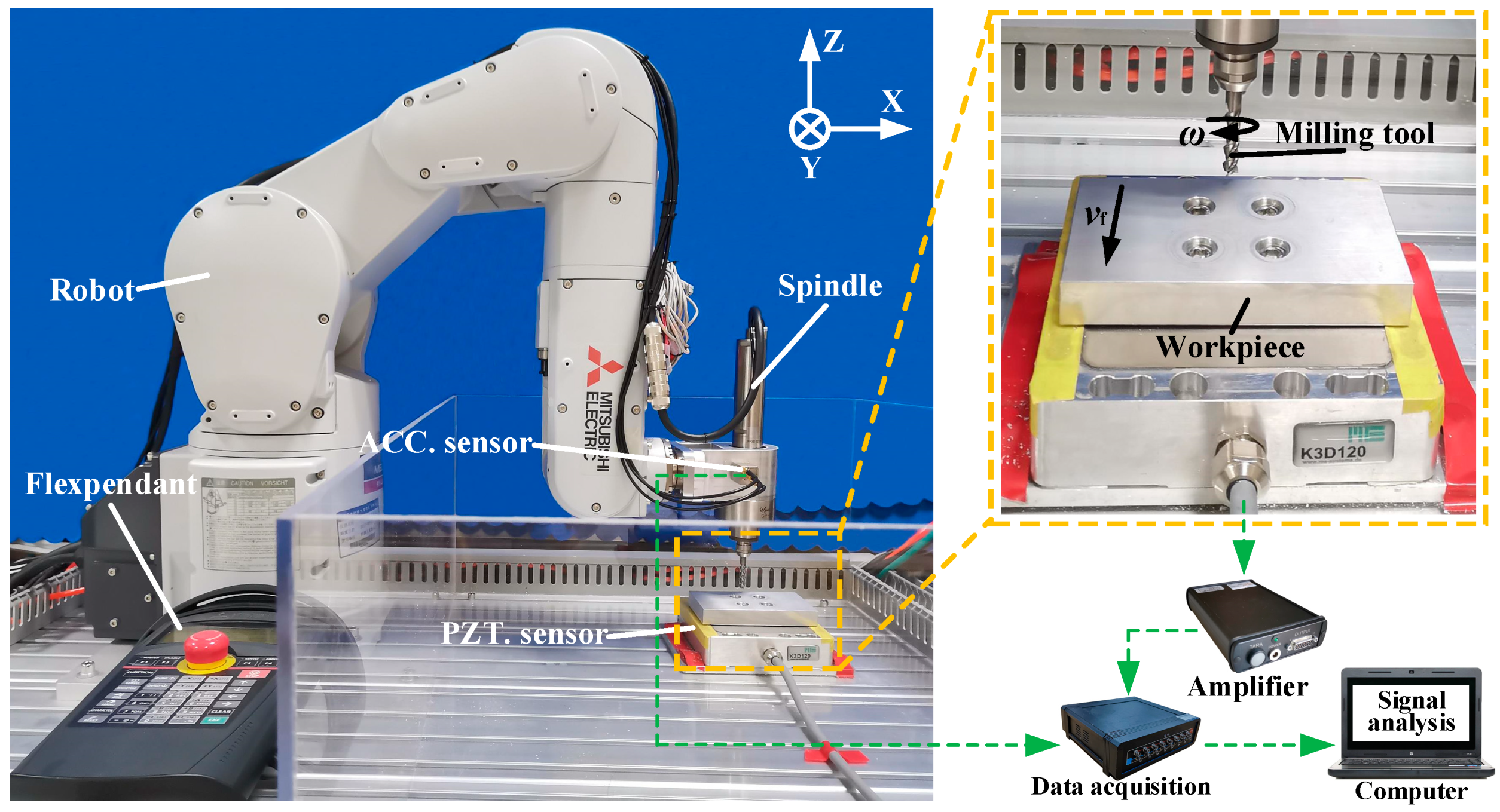


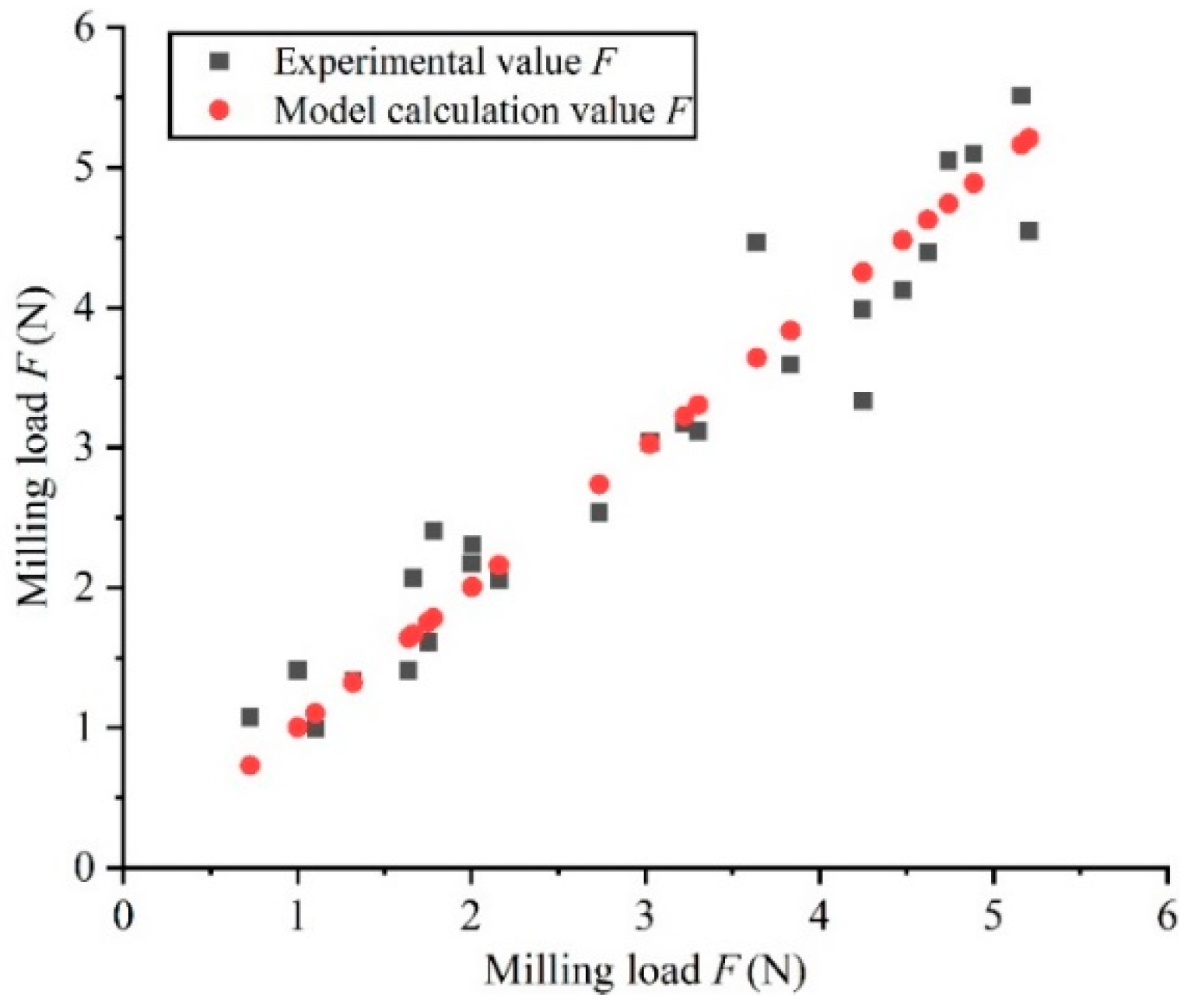
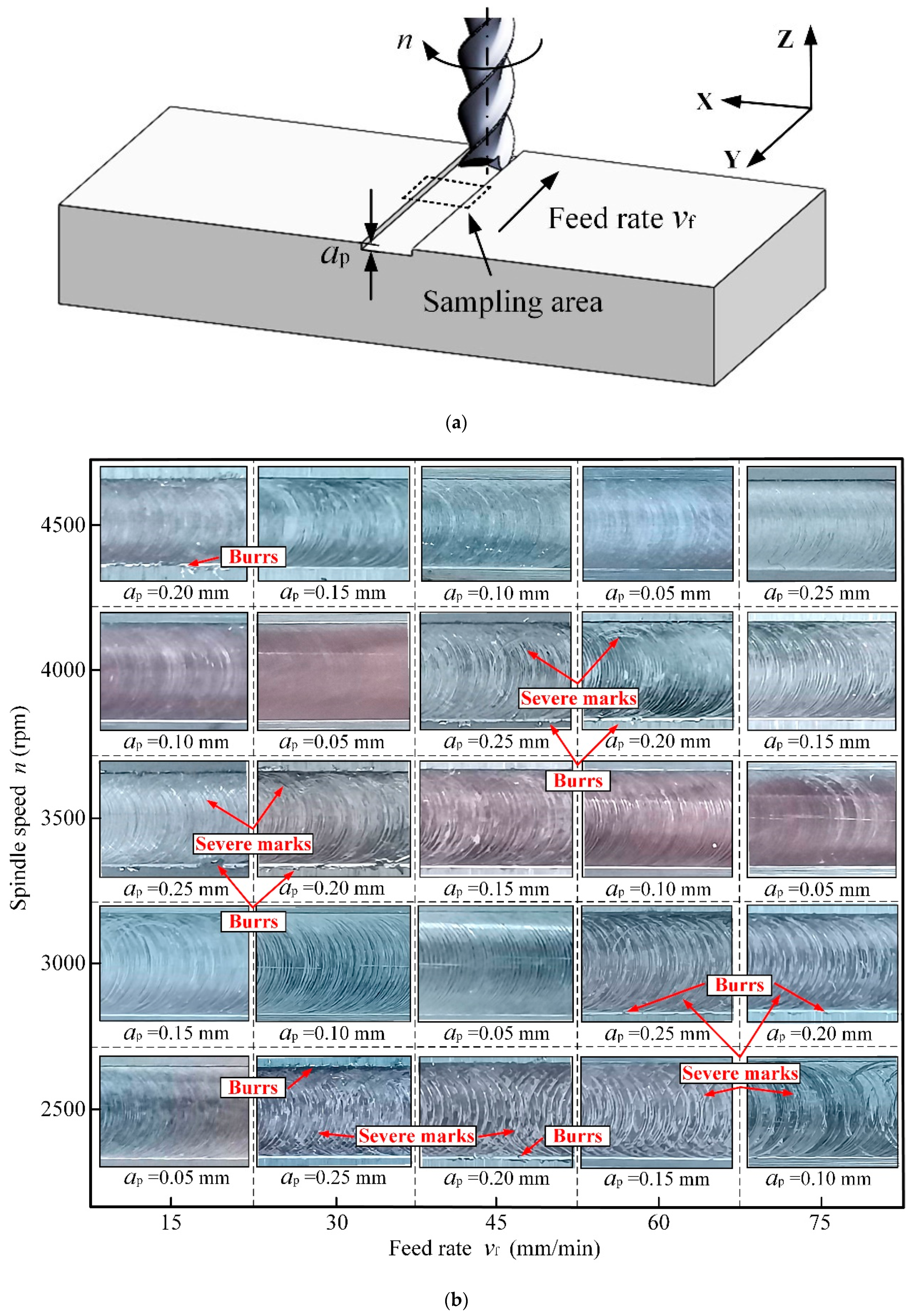
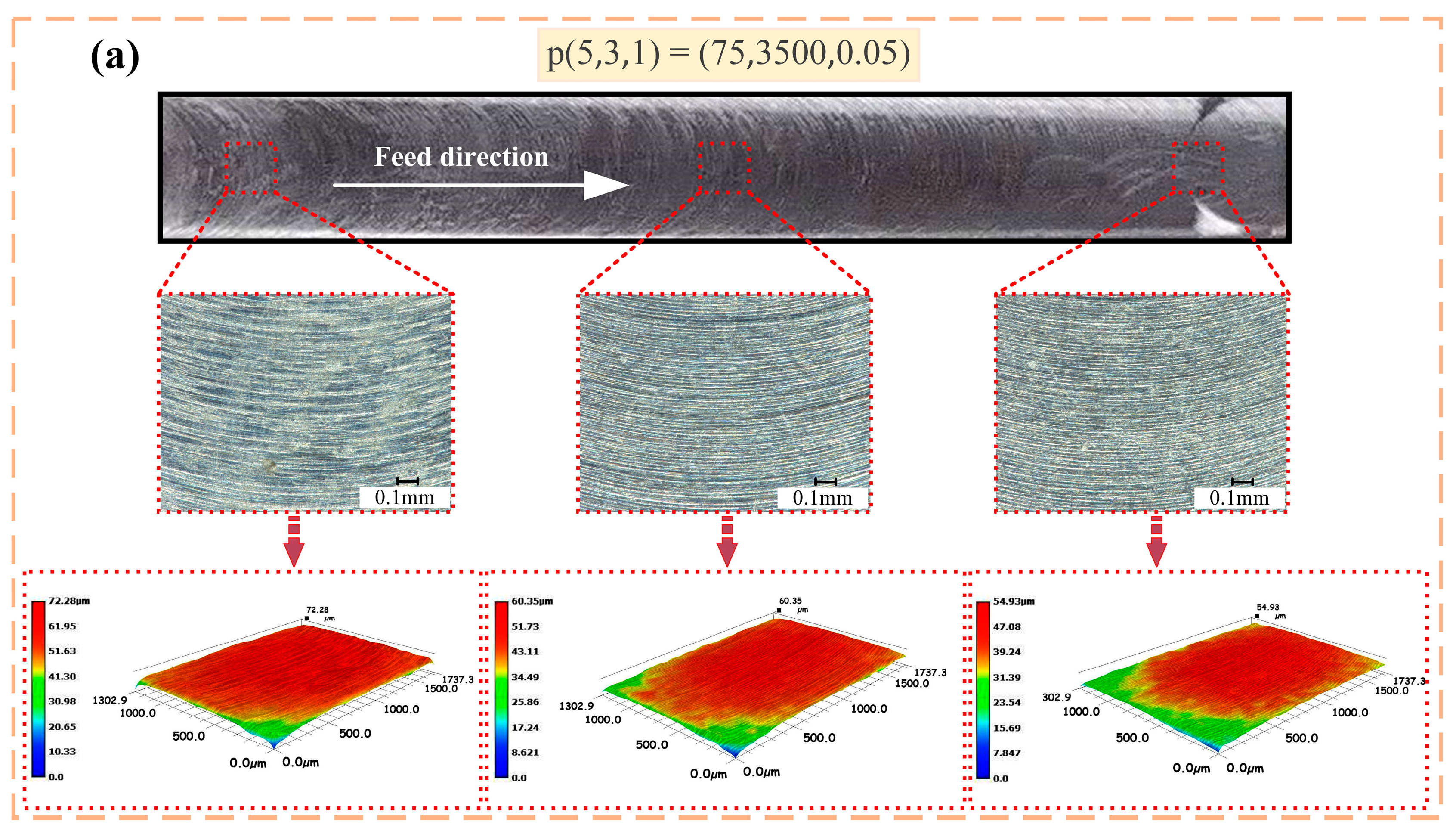
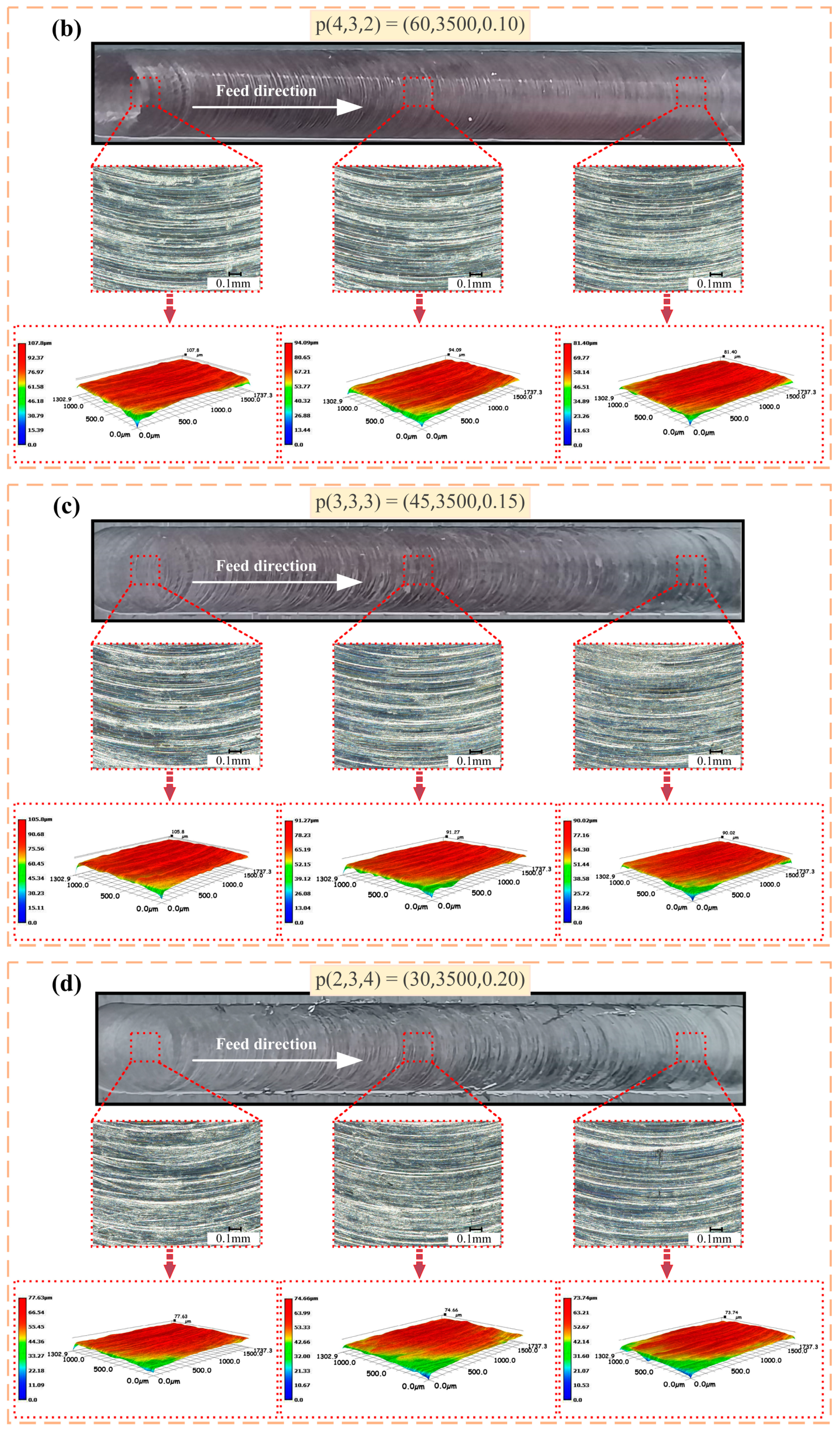
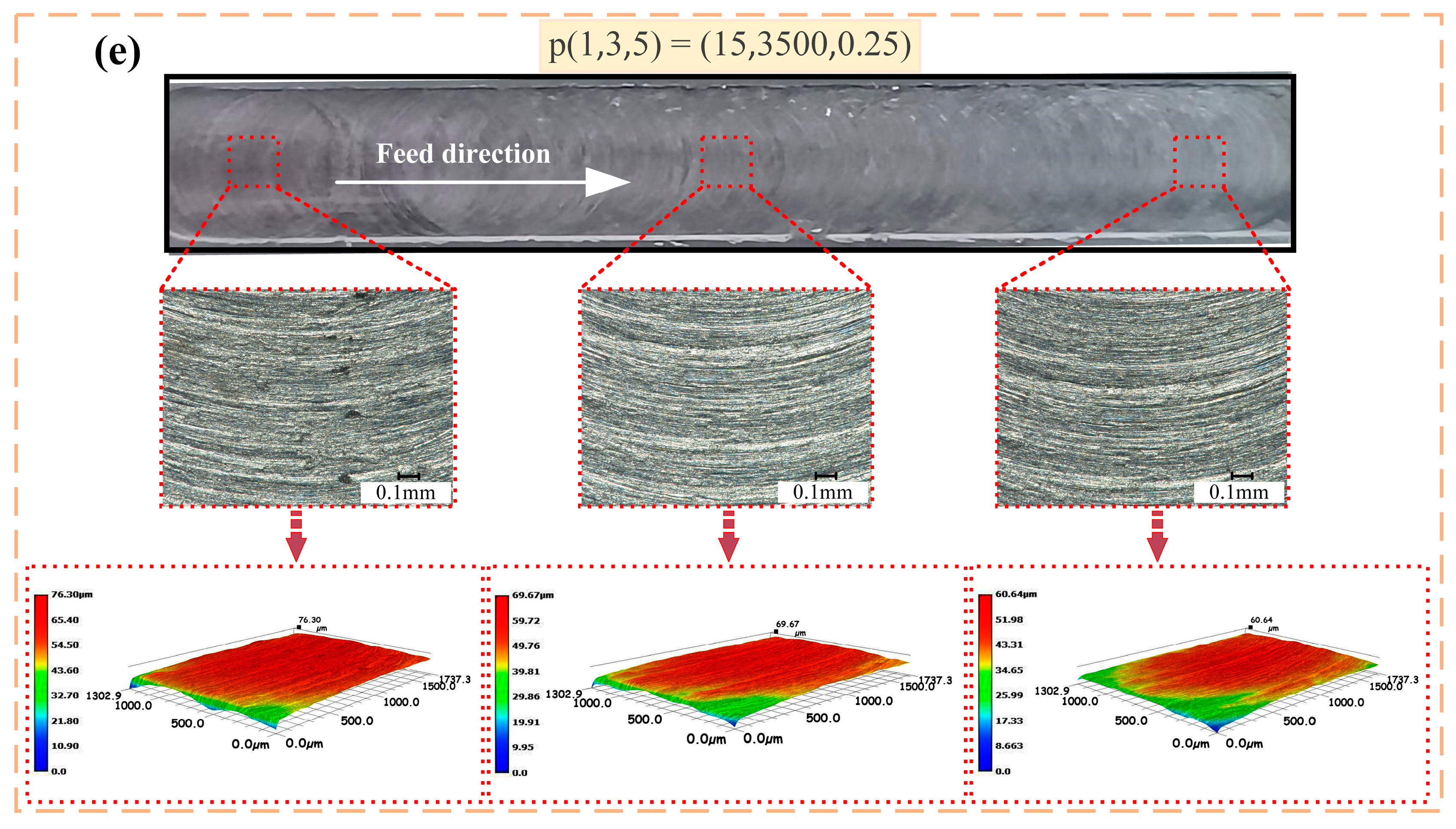
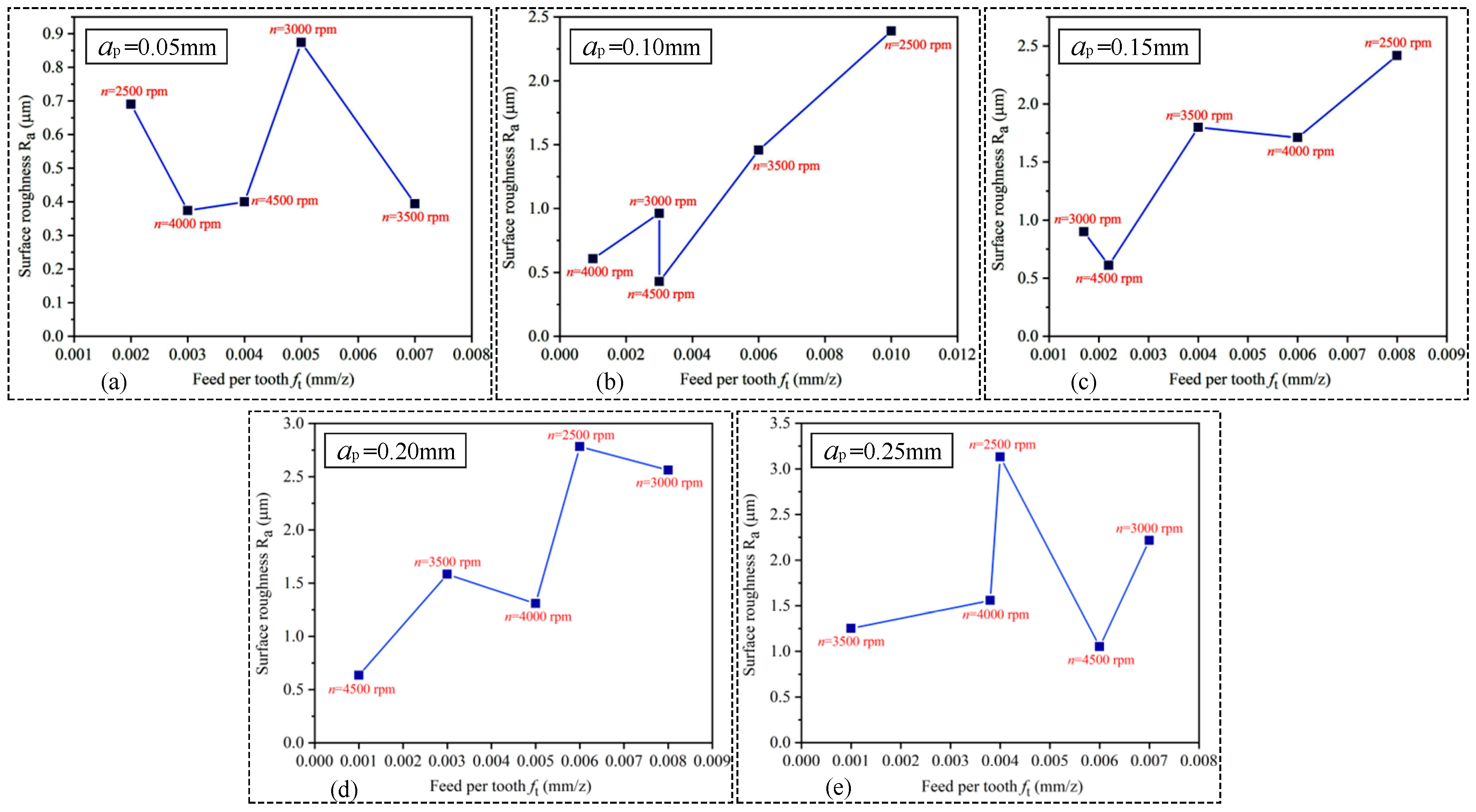
| Element | Ti | Si | Mn | Mg | Fe | Cr | Zn | Cu | Al |
|---|---|---|---|---|---|---|---|---|---|
| wt.% | 0.2 | 0.4 | 0.3 | 2.1~2.9 | 0.5 | 0.18~0.28 | 5.1~6.1 | 1.2~2.0 | Remainder |
| Properties | Density (g/cm3) | Hardness (HB) | Yield Strength (MPa) | Tensile Strength (MPa) | Elastic Modulus (G Pa) | Elongation (%) |
|---|---|---|---|---|---|---|
| Value | 2.81 | 150 | 503 | 572 | 71.7 | 11 |
| Parameters of Robot | Parameters of Spindle | ||
|---|---|---|---|
| Properties | Value | Properties | Value |
| Body weight (kg) | 41 | Motor model | EM-3030T-J |
| Operating radius (mm) | 649 | Rated power (W) | 350 |
| Rated load (kg) | 4 | Rated speed (rpm) | 7500 |
| Repeatability (mm) | ±0.02 | Maximum speed (rpm) | 30,000 |
| The number of axis | 6 | Cooling method | Air cooling |
| Factor | Level 1 | Level 2 | Level 3 | Level 4 | Level 5 |
|---|---|---|---|---|---|
| 0.05 | 0.10 | 0.15 | 0.20 | 0.25 | |
| 2500 | 3000 | 3500 | 4000 | 4500 | |
| 15 | 30 | 45 | 60 | 75 |
| Test No. | Milling Depth (mm) | Spindle Speed (rpm) | Feed Rate (mm/min) | Surface Roughness | |||||||
|---|---|---|---|---|---|---|---|---|---|---|---|
| 1 | 0.05 | 2500 | 15 | 0.593 | −0.840 | 0.401 | 1.104 | 0.690 | 3.800 | 3.722 | 4.926 |
| 2 | 0.05 | 3000 | 45 | 0.974 | −1.172 | 0.603 | 1.639 | 0.874 | 5.291 | 5.735 | 8.344 |
| 3 | 0.05 | 3500 | 75 | 1.040 | −1.288 | 0.574 | 1.752 | 0.394 | 1.981 | 0.993 | 3.187 |
| 4 | 0.05 | 4000 | 30 | 0.469 | −0.521 | 0.196 | 0.728 | 0.374 | 1.236 | 0.591 | 1.731 |
| 5 | 0.05 | 4500 | 60 | 0.774 | −1.022 | 0.314 | 1.320 | 0.400 | 1.510 | 0.934 | 4.205 |
| 6 | 0.10 | 2500 | 75 | 1.957 | −2.064 | 1.521 | 3.225 | 2.389 | 9.999 | 12.282 | 17.647 |
| 7 | 0.10 | 3000 | 30 | 0.993 | −1.180 | 0.631 | 1.666 | 0.962 | 5.962 | 6.313 | 8.581 |
| 8 | 0.10 | 3500 | 60 | 1.312 | −2.293 | 0.712 | 2.736 | 1.457 | 6.797 | 7.241 | 13.938 |
| 9 | 0.10 | 4000 | 15 | 0.462 | −0.834 | 0.309 | 1.002 | 0.607 | 2.474 | 2.243 | 6.686 |
| 10 | 0.10 | 4500 | 45 | 1.273 | −1.653 | 0.559 | 2.160 | 0.428 | 1.775 | 0.938 | 6.000 |
| 11 | 0.15 | 2500 | 60 | 2.616 | −2.723 | 1.943 | 4.247 | 2.417 | 11.375 | 16.352 | 34.115 |
| 12 | 0.15 | 3000 | 15 | 0.875 | −1.754 | 0.413 | 2.003 | 0.900 | 6.257 | 5.616 | 12.043 |
| 13 | 0.15 | 3500 | 45 | 1.754 | −2.714 | 0.688 | 3.304 | 1.799 | 9.378 | 11.108 | 27.335 |
| 14 | 0.15 | 4000 | 75 | 2.179 | −2.954 | 1.112 | 3.835 | 1.711 | 9.537 | 11.602 | 30.964 |
| 15 | 0.15 | 4500 | 30 | 0.978 | −1.431 | 0.412 | 1.782 | 0.612 | 3.150 | 4.337 | 13.167 |
| 16 | 0.20 | 2500 | 45 | 2.360 | −2.385 | 1.412 | 3.640 | 2.782 | 18.605 | 17.51 | 43.471 |
| 17 | 0.20 | 3000 | 75 | 3.088 | −3.208 | 1.630 | 4.742 | 2.562 | 21.404 | 18.388 | 49.884 |
| 18 | 0.20 | 3500 | 30 | 1.689 | −3.872 | 0.473 | 4.251 | 1.583 | 9.198 | 10.724 | 29.248 |
| 19 | 0.20 | 4000 | 60 | 2.347 | −3.667 | 1.048 | 4.478 | 1.308 | 9.066 | 6.675 | 30.815 |
| 20 | 0.20 | 4500 | 15 | 0.946 | −1.761 | 0.171 | 2.006 | 0.634 | 3.594 | 4.785 | 15.699 |
| 21 | 0.25 | 2500 | 30 | 2.516 | −4.513 | 0.625 | 5.205 | 3.131 | 22.403 | 21.864 | 51.942 |
| 22 | 0.25 | 3000 | 60 | 3.488 | −3.575 | 1.300 | 5.161 | 2.216 | 18.578 | 16.791 | 44.044 |
| 23 | 0.25 | 3500 | 15 | 0.610 | −2.956 | 0.209 | 3.026 | 1.252 | 10.590 | 10.723 | 32.704 |
| 24 | 0.25 | 4000 | 45 | 2.382 | −3.941 | 0.423 | 4.624 | 1.558 | 10.933 | 9.856 | 33.901 |
| 25 | 0.25 | 4500 | 75 | 3.102 | −3.718 | 0.661 | 4.887 | 1.051 | 7.033 | 6.896 | 29.100 |
| Factor | SS | D | MS | F | Contribution (%) | Significance | Rank |
|---|---|---|---|---|---|---|---|
| 33.728 | 4 | 8.432 | 41.968 | 69.25% | Highly significant | Milling depth-1 Feed rate-2 Spindle speed-3 | |
| 2.814 | 4 | 0.704 | 3.501 | 5.78% | Not significant | ||
| 11.358 | 4 | 2.840 | 14.133 | 23.32% | Significant | ||
| Error | 2.411 | 12 | 0.201 | 1.65% | |||
| Total | 50.311 | 24 |
| Factor | Milling Depth | Spindle Speed | Feed Rate | |
|---|---|---|---|---|
| Levels | ||||
| 0.546 | 2.282 | 0.817 | ||
| 1.144 | 1.503 | 1.332 | ||
| 1.488 | 1.297 | 1.464 | ||
| 1.774 | 1.112 | 1.560 | ||
| 1.842 | 0.601 | 1.621 | ||
| Test No. | Milling Depth (mm) | Spindle Speed (rpm) | Feed Rate (mm/min) | Feed Per Tooth (mm/z) | |
|---|---|---|---|---|---|
| 1 | 0.05 | 2500 | 15 | 0.002 | 0.690 |
| 2 | 0.05 | 3000 | 45 | 0.005 | 0.874 |
| 3 | 0.05 | 3500 | 75 | 0.007 | 0.394 |
| 4 | 0.05 | 4000 | 30 | 0.003 | 0.374 |
| 5 | 0.05 | 4500 | 60 | 0.004 | 0.400 |
| 6 | 0.10 | 2500 | 75 | 0.010 | 2.389 |
| 7 | 0.10 | 3000 | 30 | 0.003 | 0.962 |
| 8 | 0.10 | 3500 | 60 | 0.006 | 1.457 |
| 9 | 0.10 | 4000 | 15 | 0.001 | 0.607 |
| 10 | 0.10 | 4500 | 45 | 0.003 | 0.428 |
| 11 | 0.15 | 2500 | 60 | 0.008 | 2.417 |
| 12 | 0.15 | 3000 | 15 | 0.002 | 0.900 |
| 13 | 0.15 | 3500 | 45 | 0.004 | 1.799 |
| 14 | 0.15 | 4000 | 75 | 0.006 | 1.711 |
| 15 | 0.15 | 4500 | 30 | 0.002 | 0.612 |
| 16 | 0.20 | 2500 | 45 | 0.006 | 2.782 |
| 17 | 0.20 | 3000 | 75 | 0.008 | 2.562 |
| 18 | 0.20 | 3500 | 30 | 0.003 | 1.583 |
| 19 | 0.20 | 4000 | 60 | 0.005 | 1.308 |
| 20 | 0.20 | 4500 | 15 | 0.001 | 0.634 |
| 21 | 0.25 | 2500 | 30 | 0.004 | 3.131 |
| 22 | 0.25 | 3000 | 60 | 0.007 | 2.216 |
| 23 | 0.25 | 3500 | 15 | 0.001 | 1.252 |
| 24 | 0.25 | 4000 | 45 | 0.004 | 1.558 |
| 25 | 0.25 | 4500 | 75 | 0.006 | 1.051 |
| Factor | SS | D | MS | F | Contribution (%) | Significance | Rank |
|---|---|---|---|---|---|---|---|
| 5.640 | 4 | 1.410 | 12.043 | 35.83% | Highly significant | Spindle speed-1 Milling depth-2 Feed rate-3 | |
| 7.561 | 4 | 1.890 | 16.144 | 48.02% | Highly significant | ||
| 2.075 | 4 | 0.519 | 4.431 | 13.18% | Significant | ||
| Error | 1.405 | 12 | 0.117 | 2.97% | |||
| Total | 16.681 | 24 |
| Factor | Milling Depth | Spindle Speed | Feed Rate | |
|---|---|---|---|---|
| Levels | ||||
| Vibration acceleration | ||||
| 2.764 | 13.236 | 5.343 | ||
| 5.401 | 11.498 | 8.390 | ||
| 7.939 | 7.589 | 9.196 | ||
| 12.373 | 6.649 | 9.465 | ||
| 13.907 | 3.380 | 9.991 | ||
| Vibration acceleration | ||||
| 2.395 | 14.346 | 5.418 | ||
| 5.803 | 10.569 | 8.766 | ||
| 9.803 | 8.158 | 9.029 | ||
| 11.616 | 6.193 | 9.599 | ||
| 13.226 | 3.515 | 10.032 | ||
| Vibration acceleration | ||||
| 4.479 | 30.420 | 14.412 | ||
| 10.570 | 24.579 | 20.934 | ||
| 23.525 | 21.282 | 23.810 | ||
| 33.823 | 20.819 | 25.423 | ||
| 38.338 | 13.613 | 26.156 | ||
| Vibration acceleration | |||||||
|---|---|---|---|---|---|---|---|
| Factor | SS | D | MS | F | Contribution (%) | Significance | Rank |
| 435.312 | 4 | 108.828 | 12.884 | 51.41% | Highly significant | Milling depth-1 Spindle speed-2 Feed rate-3 | |
| 309.439 | 4 | 77.360 | 9.158 | 36.55% | Highly significant | ||
| 68.076 | 4 | 17.019 | 2.015 | 8.04% | Not significant | ||
| Error | 101.362 | 12 | 8.447 | 4.00% | |||
| Total | 914.190 | 24 | |||||
| Vibration acceleration | |||||||
| Factor | SS | D | MS | F | Contribution (%) | Significance | Rank |
| 391.319 | 4 | 97.830 | 14.126 | 47.17% | Highly significant | Milling depth-1 Spindle speed-2 Feed rate-3 | |
| 343.628 | 4 | 85.907 | 12.405 | 41.42% | Highly significant | ||
| 66.909 | 4 | 16.727 | 2.415 | 8.06% | Not significant | ||
| Error | 83.105 | 12 | 6.925 | 3.35% | |||
| Total | 884.961 | 24 | |||||
| Vibration acceleration | |||||||
| Factor | SS | D | MS | F | Contribution (%) | Significance | Rank |
| 4232.908 | 4 | 1058.227 | 31.128 | 75.97% | Highly significant | Milling depth-1 Spindle speed-2 Feed rate-3 | |
| 748.435 | 4 | 187.109 | 5.504 | 13.43% | Significant | ||
| 454.423 | 4 | 113.606 | 3.342 | 8.16% | Not significant | ||
| Error | 407.952 | 12 | 33.996 | 2.44% | |||
| Total | 5843.718 | 24 | |||||
Publisher’s Note: MDPI stays neutral with regard to jurisdictional claims in published maps and institutional affiliations. |
© 2022 by the authors. Licensee MDPI, Basel, Switzerland. This article is an open access article distributed under the terms and conditions of the Creative Commons Attribution (CC BY) license (https://creativecommons.org/licenses/by/4.0/).
Share and Cite
Ni, J.; Dai, R.; Yue, X.; Zheng, J.; Feng, K. Contribution Ratio Assessment of Process Parameters on Robotic Milling Performance. Materials 2022, 15, 3566. https://doi.org/10.3390/ma15103566
Ni J, Dai R, Yue X, Zheng J, Feng K. Contribution Ratio Assessment of Process Parameters on Robotic Milling Performance. Materials. 2022; 15(10):3566. https://doi.org/10.3390/ma15103566
Chicago/Turabian StyleNi, Jing, Rulan Dai, Xiaopeng Yue, Junqiang Zheng, and Kai Feng. 2022. "Contribution Ratio Assessment of Process Parameters on Robotic Milling Performance" Materials 15, no. 10: 3566. https://doi.org/10.3390/ma15103566
APA StyleNi, J., Dai, R., Yue, X., Zheng, J., & Feng, K. (2022). Contribution Ratio Assessment of Process Parameters on Robotic Milling Performance. Materials, 15(10), 3566. https://doi.org/10.3390/ma15103566







